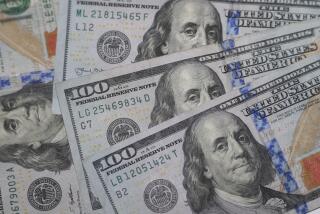1995-96 REVIEW AND OUTLOOK : MUTUAL FUNDS : 1995’s Legacy: An Embarrassment of Riches : The Average U.S. Stock Fund Rose About 30% for the Year
- Share via
Happy new year. But stock mutual fund investors won’t soon forget the old year.
Powered by falling interest rates, surprisingly strong corporate earnings and a record-busting avalanche of cash into mutual funds, the U.S. stock market in 1995 enjoyed its best year in decades.
As trading ended Friday, fund investors were staring at a lush crop of capital gains fertilized in large part by their own dollars.
The average general U.S. stock fund rose about 30% for the year, with roughly 3% of that added in the fourth quarter, according to preliminary data from fund tracker Lipper Analytical Services in New York.
That full-year performance was the biggest annual gain since the 35.6% surge in general stock funds in 1991, following the bear market of 1990.
The U.S. fund average trailed the returns on blue-chip stock indexes such as the Standard & Poor’s 500, which rocketed 34.1% in price for the year and posted a total return--including dividends--of about 37%.
The funds’ under-performance stemmed from the relative weakness of smaller stocks, which dominate many fund portfolios and which couldn’t keep pace with the dramatic advance of some of America’s best-known shares, such as Coca-Cola, Philip Morris and General Electric.
Meanwhile, international stock funds, the rage with many individual investors in 1993, struggled through another disappointing year as foreign stock markets in general badly trailed the U.S. market.
The average international stock fund rose about 9.2% for the year, according to Lipper.
Nonetheless, arguably the only major embarrassment suffered by the mutual fund industry in 1995 was one of riches: Record investor purchases of U.S. stock funds helped propel total fund industry assets (including bond and money market funds) to $2.78 trillion by the end of November, up $622 billion for the year.
But individual investors’ ravenous appetite for domestic stock funds, and the spectacular 1995 gains in the U.S. market overall, naturally have become a source of worry. Some Wall Street analysts fear the market is in a classic speculative blow-off stage, which will give way to a horrendous crash sooner than later.
Some experts say the recent crack in the technology stock sector, which had led the market for much of 1995, could be a sign that the bull market is breathing its last.
The average technology stock fund, which was up 47% in the first nine months of 1995, ended the year up about 36%. Latecomers to the tech party obviously are wincing.
Wall Street bulls, however, say that while the bears will inevitably be right someday, it would be extraordinary to see the stock market simply fall apart given the current backdrop: still-declining interest rates, still-rising corporate earnings and arguably still-reasonable valuations on many U.S. stocks.
Even after this year’s surge, the average U.S. blue-chip stock is priced at between 14 and 16 times estimated 1996 operating earnings per share--a valuation that ranks only about average, historically, given the current level of interest rates and inflation.
But if most market pros remain optimistic about a further advance in U.S. stocks in 1996, many also suggest that investors should hedge their bets by moving more money into foreign stock funds.
After a year like this one, “it’s generally prudent to rebalance your portfolio and move some money to underappreciated areas,” says John Rekenthaler, analyst at fund tracker Morningstar Inc. in Chicago.
More to Read
Inside the business of entertainment
The Wide Shot brings you news, analysis and insights on everything from streaming wars to production — and what it all means for the future.
You may occasionally receive promotional content from the Los Angeles Times.










